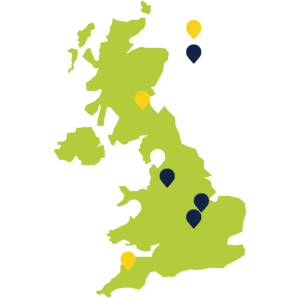Large scale farm carbon footprinting and is not yet in place in the UK, and since 2022 we have been working with Promar and Agrecalc on a project known as Activate UK, to measure emissions from farming enterprises which represent 11% and 12% of our beef and lamb volumes, respectively. Farm carbon footprints are undertaken every 18-24 months and farmers receive feedback reports explaining their emissions hotspots, along with recommended actions and practice changes to reduce emissions. Such recommendations are aligned with the Teagasc Marginal Abatement Cost Curve and based on each farms’ bespoke enterprise and risk appetite.

Goal
To drive measurable improvements in on-farm sustainability and accelerate climate action by providing farms with the quality data, tools, benchmarking insights and bespoke advice needed to deliver long term economic sustainability and profitability.
Progress
Round one of the farm carbon footprint collected data from 2021-2022 from 487 farming enterprises, which yielded bespoke Dunbia weighted average carbon footprints, which have been used to calculate our baseline emissions.
The tables show the simple average carbon footprints by beef and lamb enterprise type from Round One, when compared to the AHDB national averages. The AHDB figures were calculated using Agrecalc data from 2018-2022, which yielded the results.
Round two is underway, collecting data from 2023-2025, expanding assessments to gather further insights into farm efficiency and sustainability, and increasing the number of Activate UK farming enterprises to over 600. Initial results will be available in Q1 2026.

Top Recommendations for Activate UK Farms from Round One
The top recommendations for Activate UK Farms from Round One, as provided by Promar Farm Advisors, are detailed below. Each Activate UK Farm received bespoke information and guidance which focused on specific topics. Additionally, we provided data to support farms in monitoring carcass performance and daily liveweight gain. Through Farm Green, knowledge has been shared with the wider supply base on how to complete a farm carbon footprint, what the footprint means and how actions to reduce emissions also improve farm efficiency and productivity.

Feed
- Action recommended to 38% of Beef Farms
- Action recommended to 41% of Lamb Farms
Actions:
Decrease age at slaughter and promote daily live weight gain through nutrition.
Promote higher quality forage.
Manage grazing strategy (mob grazing).
Increase the share of home-grown feed or reducing purchased feed and purchased soy.
Establish multi species lays for a more diverse ration and increased digestibility.

Fertilizer
- Action recommended to 26% of Beef Farms
- Action recommended to 23% of Lamb Farms
Actions:
Establish a nutrient management plan.
Sample manure to understand availability of Nitrogen.
Establish a plan for Farm Yard Manure Management and application techniques.
Liming.

Animal Health
- Action recommended to 2% of Beef Farms
- Action recommended to 6% of Lamb Farms
Actions:
Create a herd management plan.
Understand what mortality and disease key performance indicators to monitor.
Establish fertility and reproduction strategies.

Soil Health
- Action recommended to 9% of Beef Farms
- Action recommended to 10% of Lamb Farms
Actions:
Soil sampling.
Minimum tillage and remedial ploughing practices.
Soil management plans.
Establish multi species lays to promote soil health.

Genetics
- Action recommended to 19% of Beef Farms
- Action recommended to 16% of Lamb Farms
Actions:
Select the genetics that are right for specific enterprises.
Select for feed efficiency, health traits, and fertility.

Other
- Action recommended to 6% of Beef Farms
- Action recommended to 5% of Lamb Farms
Actions:
Actions such as use of renewable energy.
Activate UK Leaders
Activate Leaders is our programme to help support farmers reduce their carbon emissions through enhanced support both technical and financial to understand the true cost/benefit of making change on farm.
The goal of this project is to accelerate climate action by working with a range of farming enterprises in the UK to demonstrate how Net Emissions* may be reached by increasing carbon storage and reducing GHG emissions, while improving long term farm economic sustainability and profitability.
* for the purposes of the projects, net emissions means total farm GHG emissions, minus carbon stored above and below ground.

Progress
In 2025, we partnered with 8 farms, known as the Activate UK Leaders, who represent a cross section of geographic locations and farming systems.
Working with the Soil Association Exchange (SAEx), each farm will be provided with robust data for decision making and rewarded for making sustainability improvements.
Enhanced data collection and outcome monitoring includes the following metrics:

Soils
- Soil Organic Matter
- Bulk denensity
- Earthworm count
- pH
- VESS
- C:N Ratio
- Soil cover %

Carbon
- Carbon balance
- Emissions
- Sequestration in: Woodland, Individual trees, Hedgerows, Soils

Biodiversity
- Space for nature
- Connectivity
- Detailed habitat map aligned to UKHAB
- Bird species abundance
- Flora species abundance
- Crop and livestock
- Hedgerow assessment
- Habitat management score

Water
- Flood risk mitigation
- Drought risk mitigation
- Nitrogen balance
- Potash balance
- Phosphate balance

Animal Welfare
- Antibiotic usage
- Welfare outcomes

People and Society
- Land access
- Community engagement
- Food production
Each farm will be provided with baseline data and supported with tools, bespoke advice and expertise to establish improvement plans, selecting the most impactful management options. As farms adopt practices to progress towards a Net Emissions position, we will work with the SAEx to model the financial impact of changes, while creating funding opportunities for participating farms to support them on this journey.
We will follow their journeys and disseminate knowledge via Farm Green.